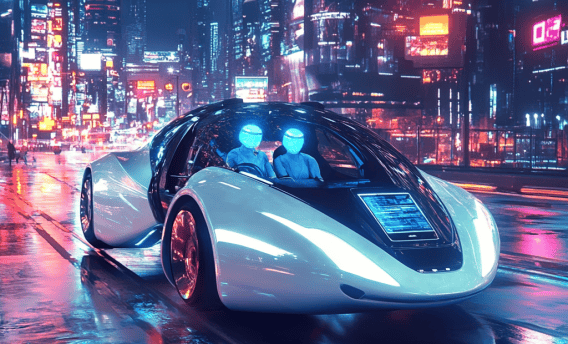Tesla Making Money For You
Future of Robo Taxis
6/5/20255 min read


Your Tesla is About to Become Your Personal Money-Making Machine 🚗💰
The future of transportation isn't just about getting from point A to point B—it's about your car working for you while you sleep, shop, or sip your morning coffee. Tesla's robotaxi vision is finally becoming reality, and it's more exciting than you might imagine.
The Revolution Starts This Month in Austin 🌟
Tesla is set to launch its long-awaited robotaxi service in Austin, Texas, by the end of June 2025, marking a pivotal moment in transportation history. The service will start with about 10 vehicles in Austin and rapidly expand to thousands of vehicles if the launch goes well with no incidents.
This isn't just another tech announcement that might happen "someday." For the past several days, Tesla has been testing self-driving Model Y cars with no one in the driver's seat on Austin public streets with no incidents, proving that the technology is ready for real-world deployment.
What makes this particularly thrilling is that Tesla aims to bring its robotaxis to Los Angeles and San Francisco following the planned Austin debut. The company isn't stopping there—they're planning a nationwide rollout that could transform how we think about car ownership entirely.
How Your Tesla Could Earn $30,000 a Year 💸
Here's where it gets incredibly interesting for women looking to build wealth through smart investments. According to Musk, Tesla owners could expect to earn up to $30,000 per year in extra cash by lending their Teslas out to anyone in need of a ride.
The math is surprisingly straightforward. Tesla calculated that the average Tesla vehicle is parked about 22 hours per day. However, by just pressing a button within the Tesla app, an owner could initiate the vehicle to autonomously pick up and drop off passengers, earning the owner around 65 cents per mile.
Think about that for a moment—your car sits idle for 22 hours every day. What if those "idle" hours could be generating income instead? A typical Model 3 could bring home over $300,000 in revenue over the course of its lifespan.
The Two-Track Strategy: Existing Cars and Purpose-Built Cybercabs 🛸
Tesla is approaching robotaxis with a brilliant dual strategy. In the short term, they're using existing Model 3 and Model Y vehicles equipped with their Full Self-Driving technology. Tesla's full autonomy solution should be compatible with vehicles equipped with Hardware 3 and Hardware 4—about 6.5 million cars globally, with ~2.5 million cars in the US.
But the long-term vision is even more compelling. Tesla expects the Cybercabs to cost under $30,000, with estimated availability in 2026. These purpose-built robotaxis will have no steering wheel or pedals and will use wireless charging technology.
The Tesla Cybercab is an upcoming two-passenger battery-electric self-driving car under development by Tesla. The vehicle is planned to be fully autonomous with no steering wheel or pedals. This isn't just a car—it's a money-making machine designed from the ground up.
Why Tesla's Approach is Different (and Smarter) 🧠
While companies like Waymo use expensive sensors and limited geographical areas, Tesla primarily relies on camera-based systems and computer vision to navigate its vehicles rather than the Waymo model of using sophisticated sensors such as lidar and radar.
Musk has said those sensors were expensive and could impede high-volume robotaxi production and scaling of a global fleet. "What will actually work best for the road system is artificial intelligence, digital neural nets and cameras," Musk said.
This camera-first approach means Tesla can scale much faster and cheaper than competitors. Tesla already has billions of miles worth of data for their AI systems to chew on from their existing fleet of vehicles on the road.
The Tesla Network: Your Passive Income Platform 📱
The beauty of Tesla's vision lies in its simplicity. Tesla owners could, in the future, allow their cars to join an autonomous ride-hailing fleet when they would otherwise be parked and unused. This would not only offer a convenient transportation service but also provide a revenue stream for the vehicle's owner.
Tesla itself would be making a nice chunk of change, earning a solid 25 percent of all revenue generated, which means 75% of the earnings go directly to you as the car owner.
Imagine building a fleet of these vehicles. If you have a fleet of self-driving Teslas transporting people in your neighborhood, there wouldn't be much to stop you from achieving an income over $100,000.
What This Means for Women Building Wealth 💪
This represents a fundamentally new way to think about assets and income generation. Traditional real estate investment requires significant upfront capital, ongoing maintenance, and dealing with tenants. With Tesla's robotaxi network, you're essentially buying an asset that generates income with minimal ongoing involvement.
The barriers to entry are also much lower than traditional investment opportunities. While you need hundreds of thousands for investment properties, you can get started with Tesla's robotaxi network for the price of a single vehicle.
"The fundamental message that consumers should be taking today is that it is financially insane to buy anything other than a Tesla," Musk said. "It will be like owning a horse in three years".
The Risks and Realities to Consider ⚖️
Of course, no investment opportunity comes without risks. According to a credible new report, Elon Musk has reportedly shut down an internal analysis from Tesla executives that showed the robotaxi business model faced significant challenges.
The report pointed to concerns that the payback around FSD and Robotaxi was going to be slow, choppy, and very difficult outside of the U.S., given the regulatory environment.
Additionally, some AV experts question whether Tesla's system — which relies on AI and a handful of inexpensive cameras, rather than a suite of redundant sensors — will be able to handle unexpected situations.
The Bottom Line: A Transportation Revolution in Our Lifetime 🌈
We're witnessing the early stages of a transportation revolution that will fundamentally change how we think about mobility, asset ownership, and passive income generation. ARK estimates Tesla could launch a robotaxi service in the next year or two, and the technology is already being tested on public roads.
While there are certainly risks and unknowns, the potential upside is extraordinary. We're talking about the possibility of your car paying for itself while you pursue other goals, build your career, or spend time with family.
For women looking to build wealth and financial independence, Tesla's robotaxi network represents an entirely new asset class—one that combines cutting-edge technology with practical income generation.
The question isn't whether this technology will arrive, but whether you'll be positioned to take advantage of it when it does.
What aspects of Tesla's robotaxi vision excite or concern you most? Are you considering Tesla ownership as part of your wealth-building strategy? Share your thoughts in the comments below!
Ready to stay ahead of the AI and technology revolution? Join our AI Woman community for weekly insights that help you navigate and profit from emerging technologies.
